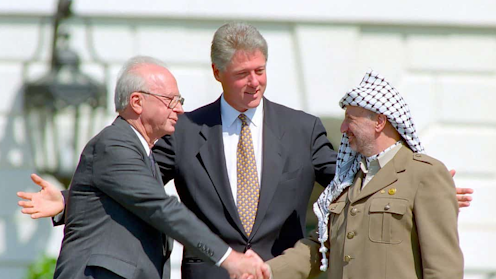Source: The Conversation – UK – By Carolina Machado Oliveira, Filmmaker, Senior Lecturer in Factual, Bournemouth University
Deep in the Amazon, sound designer Eric Terena has been capturing the sounds of the rainforest while sitting silently beneath the dense, towering treetops with his recording equipment. He has noticed some huge changes.
“What the environment once spoke, what biodiversity once sang, has shifted to sounds from industrial projects that have arrived in our territories,” said Terena, co-founder of Mídia Indígena, a Brazilian media and communications network which promotes and preserves Indigenous cultures.
His words describe more than a change in sound – they show how nature is gradually being replaced by machines. Ancestral songs have been drowned out by industrial noise. Terena shares these changes using digital tools to bring local stories to global audiences, turning lived experience into climate knowledge.
In our research with Indigenous communities in the Brazilian Amazon, we examine how film and other media technologies, from smartphones to social platforms, are being used to document environmental change, defend land rights and influence climate debates. Together with Indigenous leaders and the Intercultural Faculty in Mato Grosso, Brazil, we explore how “educommunication” – which combines media education with active community participation – can build the technical skills and political capacity that young communicators need to tell their stories to different audiences, from local villagers to global leaders.
As Cop30, the UN climate summit, comes to Brazil this November, our research shows how these digital tools are enabling Indigenous voices to help reshape global understanding of the climate crisis – ensuring their perspectives are present not only in cultural storytelling, but in international environmental decision-making.
A pivotal shift
This shift didn’t happen overnight. It began with a few voices that grew into a movement. Terena co-founded Mídia Indígena in 2017 at the Free Land Camp, a yearly Indigenous rights gathering in Brasília. Alongside him, a group of young Guajajara leaders (Indigenous peoples from Maranhão, Brazil) launched the platform, training 128 young Indigenous people how to report, record and share their stories. Mídia Indígena has grown quickly – its videos now receive more than 10 million views each year.
At the heart of this work is a powerful idea: “Nothing about us, without us.” Indigenous people can now tell their own stories without relying on outsiders to speak for them. They decide what to film, how to tell a story, and who sees it.
The impact of this shift became clear during the Yanomami humanitarian crisis in early 2023. The Yanomami, one of the largest Indigenous groups in the Amazon, live across northern Brazil and southern Venezuela in territories deeply affected by illegal gold mining. That year, reports emerged of severe malnutrition, child deaths and mercury poisoning caused by mining operations contaminating rivers and destroying forest ecosystems.
Because Mídia Indígena’s reporters were already present in the territory, they were the first to document and publish evidence of the crisis. Their coverage not only exposed the immediate health emergency but also linked it to broader issues of environmental destruction and climate change. National and international outlets eventually followed with their own reports – but only after Indigenous journalists had already broken the story.
This was more than journalism; it was lived truth, rooted in a deep knowledge of the land. Mídia Indígena’s reporting had an authenticity that no outsider could match.
And they are not alone. Young communicators from Xingu+, a network from the Xingu River basin and surrounding Indigenous territories in Brazil, created a powerful video called Fire is burning the eyes of Xingu, showing illegal fires destroying parts of the Amazon. Their video caught the attention of the US Agency for International Development and the EU, emphasising how local stories can prompt global awareness.
Films by the Ijã Mytyli Manoki and Myki Cinema Collective, founded in 2020 by two neighbouring Indigenous peoples of Mato Grosso, show how traditional knowledge and rituals are being praised in Europe, even if they’re less known in Brazil. As filmmaker Renan Kisedjê said in the short film Our Grandparents Hunted Here, “we are digital warriors”. Where once bows and arrows defended the land, today cameras and smartphones continue the fight for land, rights and justice.
Challenging outdated ideas
Collectives such as Mídia Guarani are another part of this digital resistance. Their videos challenge outdated ideas about Indigenous life and show how deeply these communities are connected to both nature and technology.
But this storytelling is not only about identity – it’s about survival. These creators shine a light on urgent threat such as Brazil’s “devastation bill”, which seeks to weaken environmental safeguards by expanding environmental self-licensing and eroding protections for traditional territories. Such measures open the door to unchecked pollution and land grabs.
By reporting on dangers like this, Indigenous communicators seek to hold governments and corporations to account. Their stories do more than inform – they generate public pressure and demand change.
This shift matters internationally too. The UK has pledged £11.6 billion in climate finance between 2021 and 2026, including £3 billion for nature restoration and £1.5 billion for forests. Yet the Independent Commission for Aid Impact, an organisation that scrutinises UK aid spending, warns that changes in accounting may have “moved the goalposts”, inflating apparent spending without ensuring impact on the ground.
Much of this funding has traditionally flowed through large international charities and foundations, such as the Rainforest Foundation UK and the International Institute for Environment and Development, which work with Indigenous communities on mapping, monitoring, advocacy and sustainable policy.
Increasingly, however, Indigenous communities are speaking directly to funding donors and shaping allocations. This shift matters because they collectively manage vast areas of land critical to conservation. While many governments invest in expensive climate technologies, these communities have long protected ecosystems through practices proven over generations.
For the first time in the history of UN climate summits, large numbers of South American Indigenous people will attend Cop30 in November – both in person and online. For a long time, they’ve been building networks to fill the gap left by mainstream media. Now, these once silenced voices are loud, clear and deeply informed.
In late August, a hundred Indigenous reporters gathered in Belém for the 1st National Meeting of Indigenous Communication. Under the motto “Indigenous communication is resistance, territory and future”, they strengthened their networks and prepared collectively for COP30.
As the world’s most experienced environmental defenders gain more power in climate talks, their stories, and the way they tell them, will help shape the decisions that affect us all.
Don’t have time to read about climate change as much as you’d like?
Get a weekly roundup in your inbox instead. Every Wednesday, The Conversation’s environment editor writes Imagine, a short email that goes a little deeper into just one climate issue. Join the 45,000+ readers who’ve subscribed so far.
![]()
The authors do not work for, consult, own shares in or receive funding from any company or organisation that would benefit from this article, and have disclosed no relevant affiliations beyond their academic appointment.
– ref. The digital movement that is enabling Indigenous people to show for themselves how the Amazon region is changing – https://theconversation.com/the-digital-movement-that-is-enabling-indigenous-people-to-show-for-themselves-how-the-amazon-region-is-changing-261616












